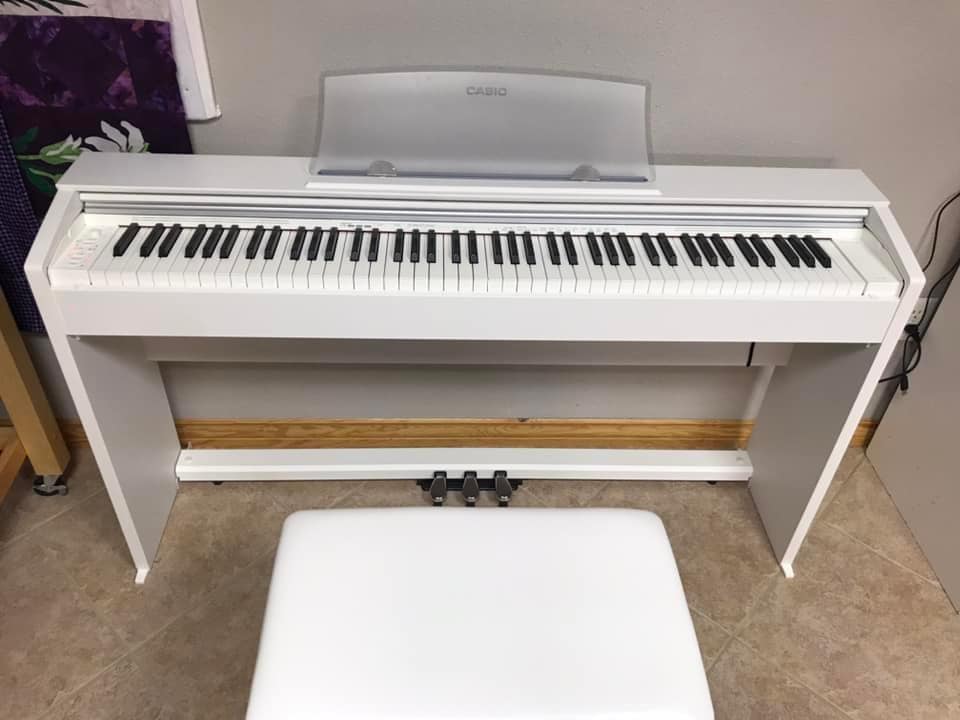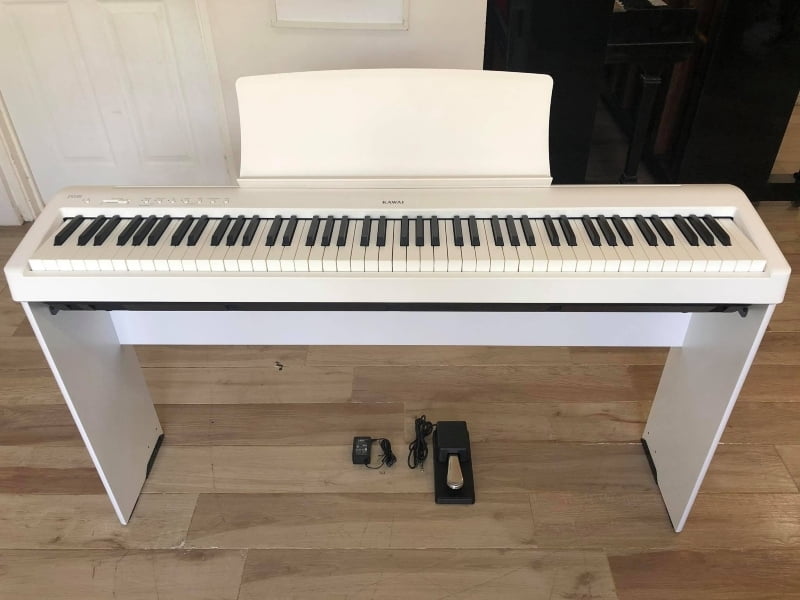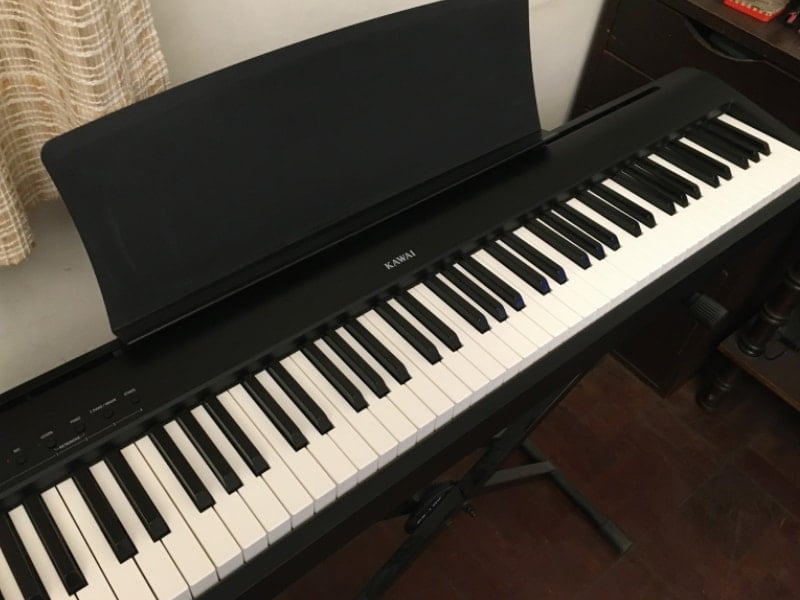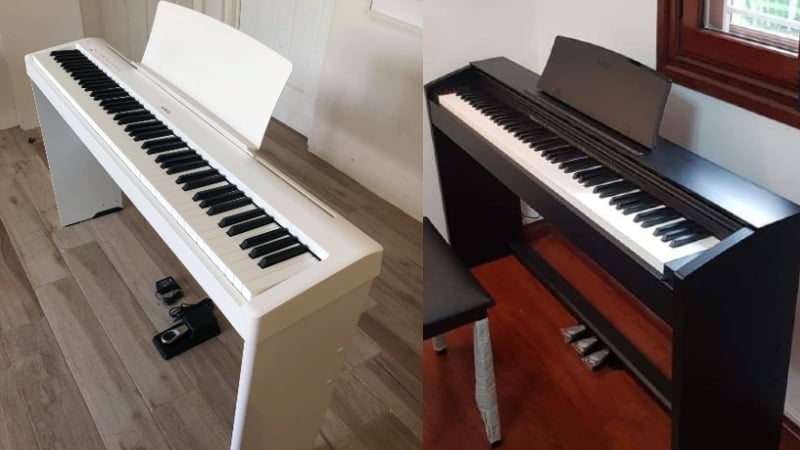In this Casio PX-770 vs Kawai ES-110 review, we dive into the features of both pianos, so you have an easier time finding the best fit for your music!
Digital pianos come in many shapes and sizes. But if you’re buying one for the first time, one of your primary considerations is probably whether to get a portable digital piano or a console instrument. This is why there are many people who end up choosing between the Casio PX-770 and the Kawai ES-110.
The Casio is a classic console digital piano that gives you premium tones at an affordable price, while the Kawai is a versatile and portable instrument that offers a lot of value for the money.
And when I conducted my Casio PX-770 vs Kawai ES-110 comparison, the versatility of the Kawai ended up pushing it ahead of the Casio PX-770.
I loved the tones and the feel of the Casio PX-770, but I couldn’t deny the flexibility you get from the piano features and portability of the Kawai ES-110, which is why I ended up choosing the Kawai as the winner.
In the rest of this review, I’ll explain this comparison in more detail and highlight the features of both pianos. That way, you won’t have to spend hours on end figuring out which piano is the best one for your needs!
Casio PX-770 vs Kawai ES-110: Comparison Chart


Last update on 2025-07-03 / Affiliate links / Images from Amazon Product Advertising API
Casio PX-770 vs Kawai ES-110: A Head to Head Comparison
There were four main categories that I used as comparison points for the Casio PX-770 and the Kawai ES-110. These were the tone, feel of piano features, and versatility of the pianos. And after taking the time and researching the pianos and comparing them based on these categories, the score was 3-2 in favor of the Kawai ES-110.
There were some areas where these two pianos were tied, and the Casio PX-770 even came out on top in one category. But at the end of the day, the versatility and flexibility you get by choosing the Kawai ES-110 were why this was my top pick.
Tone
The winner: Tie
If you only judge these pianos based on the sound, you won’t be able to find a winner. This is because, in terms of tone quality and variety, these two pianos are tied. While they run on different tone generators, they produce a similar quality of sound, so neither of these pianos was able to beat out the other.
+Tone Generator
When you strip these pianos down to the basic features, they both have sample-based tone generators. Basically, this means that the pianos are loaded with pre-recorded samples of real pianos and other instruments. Then, when you press a key, you trigger these sounds, which is how most digital pianos in this price range work.
That said, you can expect higher-quality sounds with these instruments compared to a cheap digital piano. This is because both manufacturers paid attention to the equipment used to record the instruments along with their recording techniques.
That way, the pianos have a much more realistic and detailed tone.
While both pianos produce the same relative sound quality, the Casio PX-770 has a slight edge regarding the grand piano tone. Since the Casio is designed to replicate an acoustic piano, it has one top-quality grand piano tone that isn’t available on a regular portable digital piano.

+Sound Library
These pianos feature a fairly varied sound library, especially since they’re digital pianos. Most digital pianos are known to have very limited options as manufacturers focus on quality over quantity with these products. However, I was pretty surprised to find that both pianos have 19 different voices in their sound libraries, which gives you a lot of tonal variety.
You can choose between traditional pianos and electric pianos, strings, bass, and even organ tones with these instruments. That way, you can play various genres of music and different styles with a singular piano.
Again, neither of the pianos has the same sound library as an arranger digital piano, but they beat out many options in the same price range.
Feel
The winner: Casio PX-770
For many people, feel is the most important characteristic of a digital piano. And between the Casio PX-770 and the Kawai ES-110, the Casio felt much more realistic. As a console digital piano, the Casio already looks more like an acoustic option, but because of its great hammer action system, it also feels like one.
+Hammer Action
The Kawai ES-110 has a great set of weighted keys with responsive hammer action. This means that aside from replicating the resistance of pressing on an acoustic piano, it also has a counterweight system so that the keys spring back as they do on a premium acoustic piano.
While this was great, I preferred the scaled hammer action system on the Casio. This is because, aside from having a decent bounce-back when you press the keys, you will notice that Casio’s bass keys are slightly heavier than the treble keys.
This is a small detail that separates your typical digital pianos from the stand-out models. If realism is your top priority when shopping for a digital piano, I have to say that the Casio does it significantly better than the Kawai ES-110.

Piano Features
The winner: Kawai ES-110
When it came down to the piano features, particularly the polyphony and effects sets, I chose the Kawai. The ES-110 is designed to be a versatile piano, which is why you can expect more features on this model compared to the Casio PX-770.
+Polyphony
Polyphony refers to a digital piano’s ability to play multiple notes at the same time. The Kawai has a 196-note polyphony, which is significantly better than the 128-note polyphony on the Casio.
While you’ll never find a piece that requires you to play 196 notes at the same time, it does come in handy when adding emotions to your playing. Remember, it’s not just the keys you’re pressing you need to worry about. If you engage the sustain pedal, then you have to count the notes being sustained as well as the ones you’re pressing down.
And if you’re stacking notes on top of each other with the sustain pedal down, then you need more polyphony. This is where the Kawai ES-110 truly shines and why I find it to be one of the top models in its price range right now.
+Effects
When it came to the effects, these pianos were about tied. This is because the pianos don’t exactly have exceptional effects sets, but they had a couple of effects that give you some control over your tone.
The Kawai came with reverb and brilliance effects. The Casio also has these effects, but you also have a couple of chorus presets to play around with. That said, the chorus effects aren’t that great, which is something to note if you plan on playing musical styles that require chorus effects.

Versatility
The winner: Kawai ES-110
The last comparison point I had when reviewing these pianos was versatility. And there was no way that the Casio PX-770 is more versatile than the Kawai ES-110. The Kawai model is designed to bring it with you to jams, lessons, or even performances.
If you’re a beginner, it’s best to have a piano that can do many jobs. That way, it’s easier to explore different areas and styles of music. And if this is something you want to do, then you’d be much better off than the Kawai ES-110.
Casio PX-770 vs Kawai ES-110: The Similarities
These are two completely different pianos, so it’s fair to assume that they don’t share that many similarities. As mentioned earlier, they have different tone engines, hammer action systems, and overall designs. However, when you look closely, you might notice some similarities you won’t have caught at first glance.
For example, while tone engines have different names, they still rely primarily on samples to produce sounds. Additionally, these pianos offer great value for the money. While I found the Kawai ES-110 to be more versatile, you get a huge bang for your buck with either model, which is why they are some of the best beginner pianos on the market.
Quick Rundown of the Casio PX-770
- IMMERSIVE GRAND PIANO SOUND – Award-winning AiR Sound Source with stereo grand piano, damper resonance, and 19 tones for rich, expressive performances.
- REALISTIC TOUCH & FEEL – 88-key Tri-Sensor II Hammer Action with ebony/ivory-feel keys, adjustable touch sensitivity, and hammer response.
- CLEAR, POWERFUL AUDIO – Built-in stereo speaker system delivers detailed, balanced sound across the full range.
- BUILT FOR LEARNING – Duet Mode, dual headphone jacks, 60 built-in songs, MIDI recorder, and Concert Play orchestral backing tracks.
- SLIM, STYLISH DESIGN – Elegant cabinet with sliding key cover fits any décor. USB-MIDI port connects easily to Mac, PC, iOS, or Android—no drivers needed.
Last update on 2025-07-03 / Affiliate links / Images from Amazon Product Advertising API
Quick Rundown of the Kawai ES-110
- 88-key Digital Stage Piano with Responsive Hammer Compact Action
- Built-in Stereo Speaker System
- Bluetooth MIDI pts
- 192-note Polyphony
- Dual Split Modes
Last update on 2025-07-03 / Affiliate links / Images from Amazon Product Advertising API
Product Videos
Related Articles to Casio Px 770
- Casio PX-770 vs Korg B2SP: A Battle of Budget Console Digital Pianos?
- Casio PX-770 vs Kawai KDP-110: The Best Console Digital Pianos on a Budget?
- Casio PX-770 vs PX-160: Should You Get A Portable or Console Digital Piano?
- Casio PX-770 vs S1000: Should You Get A Portable or Console Digital Piano?
- Casio PX-770 vs 750: Finding the Best Budget Digital Piano
- Casio PX-770 vs PX-860: Should You Get A Portable or Console Digital Piano?
- Casio PX-770 Vs AP-270: Which Casio Model Wins Out?
- Casio PX-770 Vs 760: Which Is The Better Casio Privia Model?
- Casio PX-770 Vs Yamaha DGX-660: Should You Get A Portable Or Console Digital Piano?
- Casio PX-770 Vs Yamaha YDP-143: Which Is The Better Piano For The Money?
- Casio PX-770 Vs Roland FP-30: Should You Get A Portable or Console Digital Piano?
- Casio PX-770 vs Yamaha YDP-144: Which Is The Better Digital Piano?
- Casio PX-770 Vs 780: What’s The Difference Between These Two Digital Pianos?
- Casio PX-770 Vs 870: Which Casio Console Digital Piano Is Better?
- Yamaha P45 vs Casio PX 770: Should You Get the Portable or Console Digital Piano?
- Yamaha P125 vs Casio PX-770 Review: Why the Yamaha P125 Beats Out the Casio Console Digital Piano
Related Articles to Kawai Es110
- Kawai ES110 Vs Alesis Recital Pro: Should You Shell Out for the Kawai ES110?
- Yamaha P125 Vs Kawai ES110 Comparison: Which Is The Best Portable Digital Piano
References:
- Casio PX-770: https://www.sweetwater.com/store/detail/PX770BK–casio-privia-px-770-black-finish
- Kawai ES-110: https://www.kawai-global.com/product/es110/
Lulacruza is an electronic folk duo operating at the junction of the hypermodern and the ancient. Our music weaves together hypnotic female singing, South American folk instruments and electronic processing, while channeling pulsating waves from the source of creation.
Lalucruza is also a community where you can connect with other music lovers to collaborate, exchange ideas and share knowledge. A platform for who wants to learns the basics of playing piano, guitar, drum masters’ technique, etc.. is the premise of our website.
